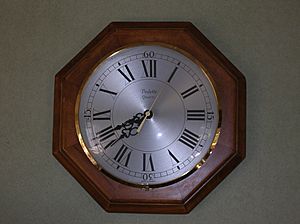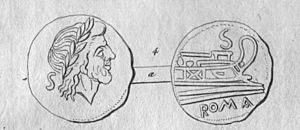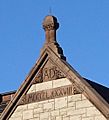Roman numerals facts for kids

Roman numerals are a numeral system that was used by ancient Rome. Numbers in this system uses letters from the Latin alphabet. Currently, it uses seven symbols:
The Europeans still used Roman numerals even after the fall of the Roman Empire. From the 14th century, the Europeans replaced Roman numerals with Arabic numerals. However, people still uses the Roman numerals to this day.
One place they are sometimes seen is on clock faces. For example, on the clock of Big Ben, the hours from 1 to 12 are written as:
-
-
- I, II, III, IV, V, VI, VII, VIII, IX, X, XI, XII
-
The IV and IX can be read as "one less than 5" (4) and "one less than 10" (9). On most Roman numeral clock faces, however, 4 is written as IIII.
Contents
Subtraction rule
There is a simple rule, whenever the same symbol is written four times, it is replaced by subtracting it from the next higher number (5,50,50,500). That way, IV is written instead of IIII (4), XL instead of XXXX (40), etc. It is used since about the Middle Ages. Usually only one number is subtracted, not two. So 18 is usually XVIII instead of IIXX. Also, the subtraction rule is only valid for the symbol which comes right beforehand in the sequence. This means that 99 is written XCIX, and not IC.
Special values
Zero
The number zero does not have its own Roman numeral. About 725, Bede or one of his colleagues used the letter N, the abbreviation (short form) of nihil (the Latin word for "nothing").
Fractions
The Romans also used fractions. The most common base for fractions was 1/12, which in Latin is called uncia (ounce).
| Fraction | Numeral | Name (nominative and genitive) | Meaning |
|---|---|---|---|
| 1/12 | · | Uncia, unciae | "Ounce" |
| 2/12 = 1/6 | ·· or : | Sextans, sextantis | "Sixth" |
| 3/12 = 1/4 | ··· or ∴ | Quadrans, quadrantis | "Quarter" |
| 4/12 = 1/3 | ···· or ∷ | Triens, trientis | "Third" |
| 5/12 | ····· or ⁙ | Quincunx, quincuncis | "Five-ounce" (quinque unciae → quincunx) |
| 6/12 = 1/2 | S | Semis, semissis | "Half" |
| 7/12 | S· | Septunx, septuncis | "Seven-ounce" (septem unciae → septunx) |
| 8/12 = 2/3 | S·· or S: | Bes, bessis | "Twice" (as in "twice a third") |
| 9/12 = 3/4 | S··· or S∴ | Dodrans, dodrantis or nonuncium, nonuncii |
"Less a quarter" (de-quadrans → dodrans) or "ninth ounce" (nona uncia → nonuncium) |
| 10/12 = 5/6 | S···· or S∷ | Dextans, dextantis or decunx, decuncis |
"Less a sixth" (de-sextans → dextans) or "ten ounces" (decem unciae → decunx) |
| 11/12 | S····· or S⁙ | Deunx, deuncis | "Less an ounce" (de-uncia → deunx) |
| 12/12 = 1 | I | As, assis | "Unit" |
Large numbers
A number of numeral systems are developed for large numbers that cannot be shown with I, V, X, L, C, D and M.
Apostrophus
One of the systems is the apostrophus, in which D is written as IƆ (500) and M is written as CIƆ (1,000). In this system, an extra Ɔ means 500, and multiple extra Ɔs are used to mean 5,000, 50,000 etc.
| Numeral | IƆ | CIƆ | CIƆƆ | IƆƆ | CCIƆƆ | CCIƆƆƆ | CCIƆƆƆƆ | IƆƆƆ | CCCIƆƆƆ | CCCIƆƆƆƆ | CCCIƆƆƆƆƆ | CCCIƆƆƆƆƆƆ |
|---|---|---|---|---|---|---|---|---|---|---|---|---|
| Value | 500 | 1,000 | 1,500 | 5,000 | 10,000 | 10,500 | 15,000 | 50,000 | 100,000 | 100,500 | 105,000 | 150,000 |
Vinculum
Another system is the vinculum, in which V, X, L, C, D and M are multiplied by 1,000 by adding an overline.
| Numeral | V | X | L | C | D | M |
|---|---|---|---|---|---|---|
| Value | 5,000 | 10,000 | 50,000 | 100,000 | 500,000 | 1,000,000 |
Usage
- In the Baltics and Russia, the days of the week, are often written as Roman numbers, I being Monday.
- When writing dates by hand, the month is sometimes written as a Roman numeral, especially for dates written in day-month-year sequence. For example: 26.XI.2014 or XI.26.2014 = 26 November 2014.
- When movies or books are published, the year of publication or year of copyright may be done as a Roman numeral.
- When people write about Monarchs or Popes, Patriarchs, or other leading figures, they are sometimes counted with Roman numbers, e.g. Queen Elizabeth II (of England), Pope John Paul II, Pope Benedict XVI, Patriarch Alexius II (of the Russian-Orthodox church)
- In France, the trimesters are sometimes counted with Roman numerals.
- In Poland, roman numerals are used to show the month in dates and as a short method of writing ordinals (i.e. VI to be 6th).
- Unicode has a code block called Number Forms, which also contains representations of Roman numerals, at the positions U+2160 to U+2188.
Write years
It is very easy to write a number as a Roman numeral. Simply substract the largest possible Roman numeral, as many times as possible from the number. This system will result in a valid Roman numeral, but will not take the subtraction rule into account.
| 1 × 1000 | + | 1 × 500 | + | 4 × 100 | + | 1 × 50 | + | 3 × 10 | + | 4 × 1 | = | 1984 |
| M | + | D | + | CCCC | + | L | + | XXX | + | IIII | = | MDCCCCLXXXIIII |
Getting the number from the numeral is equally simple, by adding the values of the symbols.
In general, the values for 5, 50, 500,.. are not subtracted. The same number, with using the subtraction rule:
| 1 × 1000 | + | (−1 × 100 + 1 × 1000) | + | 1 × 50 | + | 3 × 10 | + | (−1 × 1 + 1 × 5) | = | 1984 |
| M | + | CM | + | L | + | XXX | + | IV | = | MCMLXXXIV |
Related pages
Images for kids
-
Roman numerals on stern of the ship Cutty Sark showing draught in feet. The numbers range from 13 to 22, from bottom to top.
-
The year number on Admiralty Arch, London. The year 1910 is rendered as MDCCCCX, rather than the more usual MCMX
-
Epitaph of centurion Marcus Caelius, showing "XIIX"
-
Excerpt from Bibliothèque nationale de France. The Roman numeral for 500 is rendered as VC, instead of D.
-
The year of construction of the Cambridge Public Library, (USA) 1888, displayed in "standard" Roman numerals on its facade.
-
Boris Yeltsin's signature, dated 10 November 1988, rendered as 10.XI.1988.
-
Business hours table on a shop window in Vilnius, Lithuania.
See also
 In Spanish: Numeración romana para niños
In Spanish: Numeración romana para niños


















